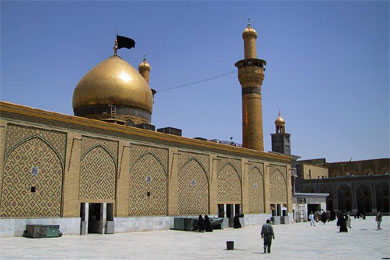By Sadia Dehlvi
April 23, 2016

Shryan of Hussain|Imam Hussain in Karbala|Sub Kay Imam Hussain|Sardar Hussain Of Jannat|
Recently, I journeyed to Iraq, visiting Najaf, Karbala and Baghdad on an invitation from the authorities of the holy shrine of Imam Hussain in Karbala. I thought it as a gift from Imam Ali, lovingly called Maula Ali, and his son Imam Hussain — both whom I love deeply. Aga Sultan Murthaza, an educationist from Bangalore and engaged in humanitarian work in Iraq helped organise this media delegation. He received us at Najaf International Airport, and bought black chadors for women delegates to cover themselves from head to toe, mandatory in the sacred cities of Najaf and Karbala. We stayed at a beautiful, comfortable and spacious complex in Karbala, built to house millions of pilgrims that come throughout the year. Najaf houses the exquisite mausoleum of Imam Ali, Prophet Muhammad’s cousin and son-in-law.
The Prophet famously said, ‘I am the gate of knowledge and Ali is its door’. Tears flowed as I stood at this door at Najaf, after decades of nurturing the desire to kiss the threshold of Imam Ali. Born inside the precincts of the Kaaba in Mecca, the Prophet named him Ali, meaning the ‘the exalted one’. It is believed that the Prophet transferred his esoteric knowledge to Imam Ali, making him the fountainhead and Imam of the Auliya, friends of Allah, now called Sufis. Maula Ali remains the vital link in spiritual lineages that connect Sufi orders to the Prophet and eventually to God.
Imam Hussain’s mausoleum complex in Karbala is one of the finest examples of Islamic architecture. Growing up observing the martyrdom of Imam Hussain in the month of Muharram and listening to Sozkhani and Noha — eulogies to Imam Hussain, I became overwhelmed with both grief and joy on touching the trellis of his mausoleum. I sat in the women’s area, trying to absorb the benevolence that seemed to fill the space. In stylised Arabic calligraphy, Prophet Muhammad’s words adorn the walls of the shrine, ‘I am from Hussain and Hussain is from me’.
At night, the whole area glitters in a golden hue; large crowds of men, women and children from different parts of the world fill the shrine complex, pathways and bazaars. Catering to the pilgrims, rows of shops sell food, toys, prayer beads and prayer mats, flags and other memorabilia with images of Imam Hussain and Imam Ali.
It’s a heady mixture of celebration, devotion and grief. Chants of Ya Hussain and Ya Ali fill the air. These invocations reach a pinnacle when bodies of those slain battling the ISIS are brought to these shrines, throughout the day and night. Karbala represents the eternal clash between truth and falsehood. Imam Hussain was martyred on this battleground in 680 CE at the hands of the tyrannical Yazid, the Ummayad ruler.
Yazid had declared himself the head of the Islamic caliphate and ordered Imam Hussain to give allegiance to him. Imam Hussain fought with just 72 companions against a huge well-equipped army. After they were martyred, the Prophet’s beloved grandson stood alone, suffering a volley of arrows but fighting bravely till his head was severed from his body, while he prostrated in prayer. The mausoleum stands at the place of his martyrdom. The camps where women of Imam Hussain’s family looked on helplessly as their men fell are marked by exquisite memorials that are popular places for collective mourning and prayer. Imam Hussain preferred to die, rather than legitimise oppression and injustice in the name of Islam. His sacrifice and courage against the face of evil, is what continues to inspire the Iraqis to fight the ISIS. Two years ago, Ayotallah Ali Sistani called on Iraqi citizenry to join Hashd, the civilian resistance force. Since then, over a Lakh volunteers have joined ranks to fight ISIS, playing a key role in reclaiming key cities. This call, made from Najaf, echoes with symbolism, for it was here that a group of Muslims disagreed with Imam Ali. They killed him with a poisoned sword and came to known as Kharijites, people out of Islam. Scholars liken terrorists to these early Kharijites, who were radicals pronouncing those who did not follow their version of Islam as apostates. The military commanders we met seemed eager to dispel the perception that the war in Iraq is between Shias and Sunnis. They inform that Sunnis make up a large part of their ranks, and that all Iraqis are united against their fight against terrorism. The roads from Najaf to the airport and to Karbala are littered with lampposts, carrying pictures and eulogies of slain Iraqi fighters.
In these troubled times, there is no family that remains unaffected. In the refugee camps, both men and women told horror stories of their escape from ISIS strongholds, children of missing school, women of the lack of money, water and food, many of their men dead or at war. Yet, they were gentle and hospitable, insisting that we share their table.
Some even enthusiastically talked about their favourite Indian films and Shahrukh Khan.
Baghdad is a different experience altogether. It’s a bustling city with chaotic traffic, jean-clad women, military check posts and armoured military vehicles zipping past. I visited the mausoleum of Shaykh Abdul Qadir Jilani, the great Sufi Master of the 12th century; another dream that came true. We couldn’t stay long enough, as Baghdad is not as safe as Najaf and Karbala. We passed the walls of Saddam Hussain’s palace, now in ruins. We drove by the Euphrates River, the waters of which were denied to Imam Hussain during the Karbala battle. Iraq is called ‘the cradle of civilisation’. Visiting these legendary cities brings alive both ancient and contemporary histories
Source: speakingtree.in/article/exalted-cities

No comments:
Post a Comment